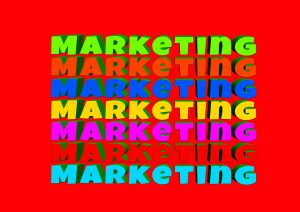Today, business owners are spoiled with choices when it comes to marketing. You’ve got ways to reach your customers that people just 30 or 40 years ago couldn’t even dream of. But, while you’re focusing on all of these endless options, are you neglecting the good old fashioned nuts and bolts of advertising, like word and color choice? The key to effective marketing might not really be magic (in fact, it takes a lot of thought!), but we can help you out with some “magic” words and convincing colors to incorporate into your marketing, so you can stand out from the crowd – no tricks required!
What’s the Marketing “Magic” Word?
No, we’re not talking about “please,” although that’s an important magic word! But just like saying “please” can influence the way a person feels about a request, using the right words in your marketing can impact buying decisions. It has been proven that you can improve audience response and inspire customers to take action with the right words and phrases. These marketing words will create positive associations, and ultimately convince them that your product or service is the one that is worth a second look (and their money). Try these “magic” marketing words in your posts and ads:
- Free – We’re starting off with a pretty obvious one, but we want to make sure that you never forget just how much people love free stuff. If you can offer anything at all for free to your customers, do so (but don’t trick them) – and then be sure to feature the word “free” prominently in your ad.
- Complimentary – This word has a similar effect to “free,” but is a good choice if you’re looking to class things up.
- You – How is this a “magic” word? Well, we’re not just talking about throwing it around in any old way, we’re talking about using it to directly address your customer, and make them feel like you are addressing them personally. After all, everyone likes to feel special.
- Savings – Telling customers that they will save money with you versus the competition will always go a long way in winning their business.

- Limited – File this along with any word or phrase (like flash sale, last chance, or act now) that implies your customers need to jump on your product or service, or they might miss out on a great offer.
- Guaranteed – Sometimes you have to remove the risk or ease your customers’ fears, and this magic word can help give them a sense of security. You can also use the word proven to lessen the sense of risk and instill confidence.
- Instant – We live in a pretty fast-paced world, where customers want instant access to everything (for example, 47% of people expect a website to load in 2 seconds!). Use this magic word to assure your customers that they won’t have to wait, thus reinforcing their buying momentum. You can also use fast or immediate to get a similar effect.
- No obligation/commitment – You need to create a win/win situation for your customers, and you can do this by implying your deal is so great that they won’t want to back out – but they can if they want to.

- Easy – Everybody’s got 99 problems. Tell them how your product or service can simplify their life; or, use this magic word to let them know that the process of becoming your customer is super streamlined. The easier it is to become a customer, the more likely they are to convert.
- Opportunity – Similar to the above magic words that create a sense of urgency, “opportunity” also implies that what you’re offering is quick and ready for the taking, so customers who are in the know shouldn’t let it pass them by.
- Exclusive – Just as addressing your customers directly can make them feel special, so too can giving them access to a deal that is meant just for them.
- See/discover – Consider adding verbs to your call to action, especially ones like these that invite customers to indulge their curiosity and explore the interesting things you have to offer.
- Enjoy – It doesn’t have to be all business – appeal to your customers’ “want” side instead of simply their “need” side and let them know that something really good awaits them.
Colorful Campaigns

Language is one thing – it’s pretty easy to understand why certain “magic” words get certain responses from customers (again, who doesn’t love free stuff?) But what about something that appeals to them on a deeper level, like color? The psychology surrounding color choice is by no means an exact science, but choosing the right color for your logo and ads can be a very important part of your marketing strategy. In fact, according to one study, 90% of snap judgements can be based on color alone.
So where do you begin when choosing colors for your brand, especially considering that there are 18 decillion colors out there (what even is a decillion?)? According to another study, the relationship of color to a brand hinges on whether or not the color is a good “fit” for the brand. For example, if you’re looking to give your brand a sense of “ruggedness,” try brown. Or, try some of these popular colors, which can influence your customers’ thinking in the following ways:
- Red – Red is a powerful color, and is strongly tied to emotions that evoke a physical response. Think love, excitement, aggression or terror. If you want to get your customers’ hearts beating and get a quick response from them, red could be the way to go.
- Green – Green is actually the easiest color for the eye to process. It tends to be used as a balancing color, one that can incorporate logic and emotion, and give a feeling of rest and stress relief. It’s also associated with nature, growth and health. All of this means that green tends to be used by both financial institutions and companies that want to be seen as environmentally friendly.
- Yellow – While green is easiest to process, yellow is the easiest color to see, so you can use it to grab customers’ attention. Yellow is also associated with “sunniness,” or optimism, and is a great way to make your customers feel inspired or to lift their spirits.
- Blue – Did you know that blue is the most popular color in the world? It is soothing, reliable, dependable, and trustworthy. Unlike red, which will get a physical response from viewers, blue tends to evoke a more mental reaction.

- Orange – Since orange is a mix of red and yellow, it tends to have some of the power of red, tempered with the fun and friendliness of yellow. It’s definitely an attention grabber, so can be used as a motivational color. Interestingly, it’s also associated with affordability. You might want to use it sparingly if you are aiming your advertising toward women, though: it is the most unpopular color with them.
- Black – Just as powerful as red, but in a different way, black is a color to use sparingly, but to really great effect. Use it to add sophistication, seriousness or a sense of independence.
- White – Using white is actually a pretty bold choice, but it can be effective – think Apple products and the clean, modern feeling they give off. It is also associated with purity, innocence, and peace.
Does effective marketing contain a touch of magic? Maybe. Hitting on that perfect combination of word and color choice can seem pretty magical, especially when you start reaping the rewards of your advertising efforts, and your business starts to grow. So get out there and work that marketing magic!



